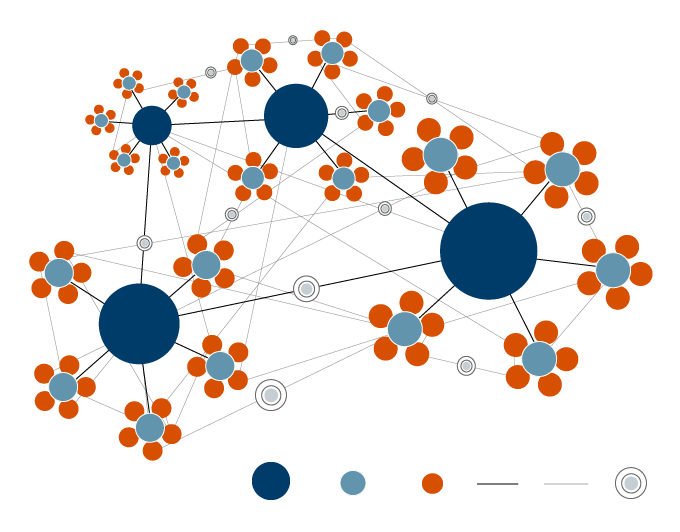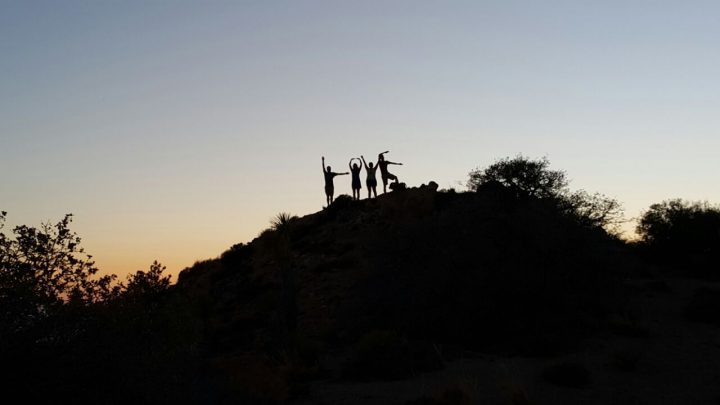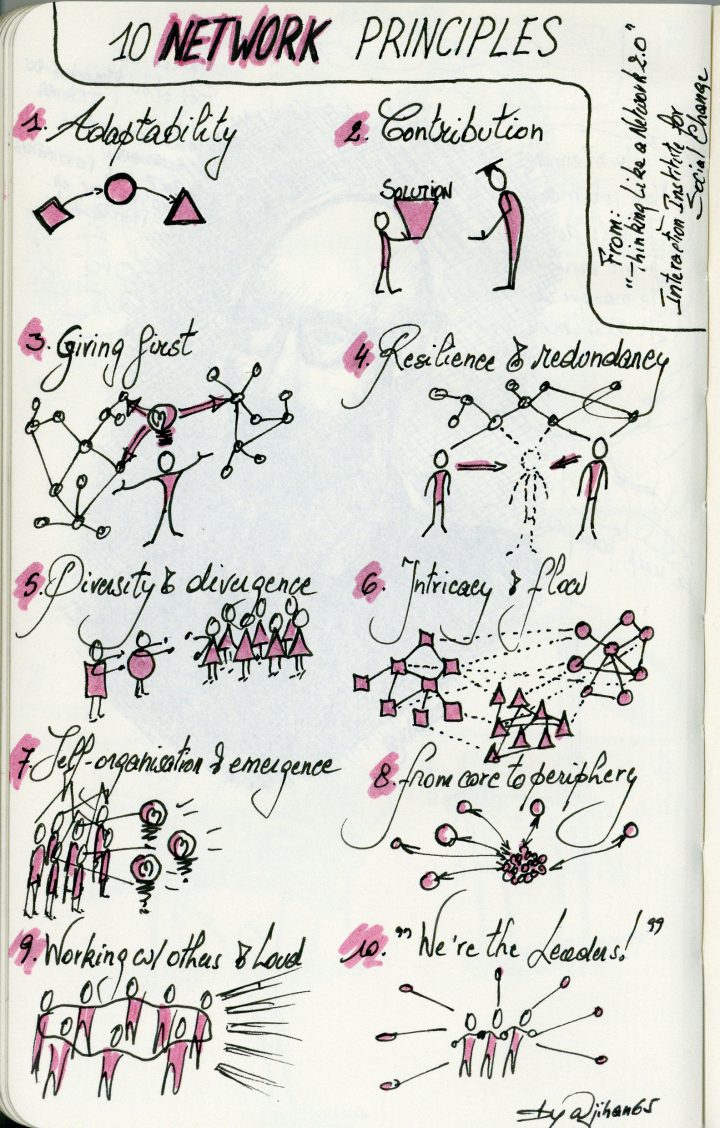Tag Archive: Networks
September 12, 2018

Image from Sharon Mollerus, shared under provisions of Creative Commons Attribution License 2.0.
As I’ve worked with a variety of social change networks to launch or transition from one stage to another, I’ve been guided by the following formula:
Form follows function follows focus
My experience is that many groups and initiatives can get very concerned about structure – How will we make decisions? Who will be members? What is expected of them? What do they get in return? These are important questions, and they deserve a fair amount of time tending to them. What can bog many groups down at this stage, however, is that they have not sufficiently sorted out the functions of the network, how it creates value, if you will, which has important implications for form. And if the group is not clear on its focus (purpose, animating goal, mission), this can be that much more perplexing.
So I’m spending more and more time with networks sorting out their core “jobs,” with a few additional guiding mantras, including:
Do what you do best and connect to the rest.
The value proposition of change networks in my mind is that they add value to a broader landscape of activity, not that they come in and try to take over. Even if this is not the intent, groups can spend little time figuring out what already exists “out there,” what efforts are underway, what other collective efforts are operating. This lack of awareness risks creating unnecessary and unhelpful duplication and competition. Read More
August 24, 2018
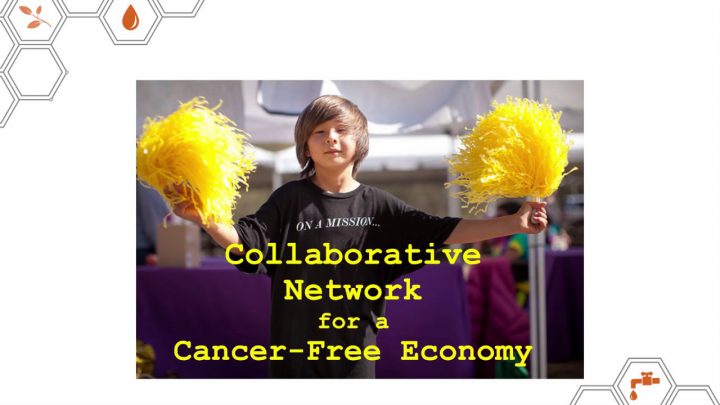
This post originally appeared on the Health and Environmental Funders Network website. It was co-authored by Fred Brown, The Forbes Funds, President & CEO; Debra Erenberg, Cancer Free Economy Network, Strategic Director; and Ruth Rominger, Garfield Foundation, Director, Collaborative Networks Program. IISC was centrally involved with the launch of the Cancer Free Economy Network, serving as lead process designer, facilitator and network coach from 2014-2017. IISC is currently supporting the development of CFEN’s network strategy.
We can do this! Within the philanthropy sector, there are so many solutions emerging around the world from people coming together to tackle the social, economic and environmental problems challenging humanity right now. We are in a time when connecting solutions together to align and reinforce each others’ progress is the most critical strategy across issue silos.
The Cancer Free Economy Network (CFEN) is one such example, where people with solutions — good ideas, strategies, initiatives, expertise, models, products and passion — are collaborating to build an economy that supports health and well being for all. These types of social change networks are held together with universal core values. In CFEN, the values are framed as simply as:
The water we drink, the air we breathe, and the products we use every day shouldn’t make us sick, cause cancer or any other disease.
The network is an open and flexible way to connect to an extended community of people who are building power together to phase out all toxic chemicals manufactured and put into industrial and consumer products that are making us sick and damaging our environment. Collectively, we know of many solutions that are readily available for moving the economy in that direction.
Like many social change networks that take a holistic, collaborative approach, people come together to connect and multiply actions aimed at shifting mindsets, structures and behaviors in many different aspects of the complex problem.
In the case of CFEN, this means there are teams from many organizations coordinating a variety of actions around toxics that together will:
-
Change the Story to show how we can prevent many cancers by addressing the toxic chemicals that are currently accepted as part of our environment.
-
Advance the science supporting health and preventing illness.
-
Shift the market from toxic chemicals to a market producing safe, healthy, and affordable materials.
-
Build the power to implement system changes across diverse constituencies.
Read More
June 18, 2018
“Words are how we think, stories are how we link.”
– Christina Baldwin
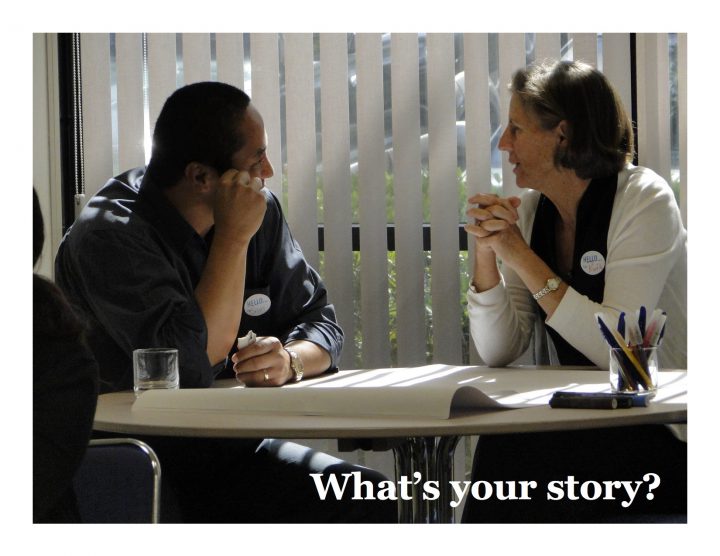
Last week I had the privilege of facilitating a two-day Network Learning Lab for a remarkable group of conservation leaders and network weavers. I co-designed the session with Olivia Millard and Amanda Wrona of The Nature Conservancy (and at the instigation of Lynn Decker of the Fire Adapted Communities Learning Network) to connect and strengthen the capacity of those working at the intersection of ecosystem health and human/community development while building networks at local, state, regional, national and global levels. Our design was informed by input given by the participating network weavers themselves about their core challenges and learning objectives, while leaving room for the unexpected – enough spaciousness for the network magic of emergence to happen.
As with other network leadership institutes that we at IISC have had a hand in designing and facilitating, the experience last week had as its foundation plenty of opportunities for the cohort to authentically connect, to get to know one another on both professional and personal levels. And as with both leadership development sessions and ongoing network development initiatives that we support, we turned to storytelling as a way to create bonds and understanding. This included time for the participants to tell brief stories about their networks, doing so in 5 minute informal bursts sprinkled throughout the two days (which could also have been done as Pecha Kucha or Ignite presentations). The intent was to create a bit more understanding of what might make each network unique in its aspirations, attributes and accomplishments and to whet people’s appetites for further conversation at breaks, meals and into the evening.
“There is no greater agony than bearing an untold story inside you.”
– Maya Angelou
We also set up a couple of exercises within the first hour of the lab for people to hear more about one another’s paths to the work they currently do, not by ticking off their resumes, but by telling stories about what happened to and moved them to be where they are now. Time and again, when I facilitate this kind of exercise, it shifts the tone of the gathering in the direction of greater openness and trust. And as we touched on in our debrief of those exercises, inviting that kind of storytelling into our work can send a signal about what is validated with respect to forms of knowing, expression and parts of ourselves to bring to the table. Along these lines, we also drew from poetry and other forms of creative expression, including a stanza from a favorite William Stafford piece, “A Ritual to Read to Each Other” which, to me, gets at the heart of network building … Read More
May 17, 2018
“Only connect! That was the whole of her sermon. Only connect the prose and the passion, and both will be exalted, and human love will be seen at its height. Live in fragments no longer.”
E.M. Forster, from Howard’s End
This is an excerpt from the final post in a series of five focused on networks for change in education and learning that have appeared on the Education Week and Next Generation Learning Challenges websites.
In this series on network design and network thinking, I explored the power and promise of networks as residing in how connection and flow contribute to life, liveliness and learning. See, especially, Connection is Fundamental.
In Why Linking Matters, I looked at how certain networks can more optimally create what are known as “network effects,” including small world reach, rapid dissemination, resilience, and adaptation.
I also noted, in Structure Matters in particular, that living systems–including classrooms, schools, school districts, and communities–are rooted in patterns of connection and flow. That’s why shifts in connections–between people, groups, and institutions–as well as flows of various kinds of resources can equate with systemic change, and ideally they can lead to greater health (in other words, equity, prosperity, sustainability).
Networks can also deliver myriad benefits to individual participants, including: inspiration; mutual support; learning and skill development; greater access to information, funding, and other resources; greater systemic or contextual awareness; breaking out of isolation and being a part of something larger; amplification of one’s voice and efforts; and new partnerships and joint projects.
It’s also true, however, that not every network or network activity creates all of these effects and outcomes. The last two posts looked at two factors that contribute to whether networks are able to deliver robust value to individual participants and the whole, including network structure and what form leadership takes. Networks are by no means a panacea to social and environmental issues and can easily replicate and exacerbate social inequities and environmentally extractive practice. So values certainly have a place, as does paying close attention to dynamics of power and privilege.
It is also the case that individual and collective behavior on a day-to-day basis have a lot to say about what networks are able to create. The following is a list of 25 behaviors for you to consider as part of your network practice as an educator:
- Weave connections and close triangles to create more intricacy in the network. Closing triangles means introducing people to one another, as opposed to networking for one’s own self, essentially a mesh or distributed structure rather than a hub-and-spoke structure.
- Create connections across boundaries/dimensions of difference. Invite and promote diversity in the network, which can contribute to resilience and innovation.
- Promote and pay attention to equity throughout the network. Equity here includes ensuring everyone has access to the resources and opportunities that can improve the quality of life and learning. Equity impact assessments are one helpful tool on this front.
- Name and work with power dynamics and unearned privilege in the direction of equity.
- Be aware of how implicit bias impacts your thinking and actions in the network. Become familiar with and practice de-biasing strategies.
- Think, learn, and work out loud, in the company of others or through virtual means. This contributes to the abundance of resources and learning in the network.
- Don’t hoard or be a bottleneck. Keep information and other resources flowing in the network.
- Identify and articulate your own needs and share them with others. Making requests can bring a network to life as people generally like to be helpful!
- Stay curious and ask questions; inquire of others to draw out common values, explicit and tacit knowledge, and other assets.
- Make ongoing generous offers to others, including services, information, connections.
For behaviors 11-25, see this link.
“… Keep reaching out, keep bringing in./This is how we are going to live for a long time: not always,/for every gardener knows that after the digging, after/the planting, after the long season of tending and growth, the harvest comes.”
Marge Piercy, from “The Seven of Pentacles”
April 18, 2018
“Network entrepreneurs are keenly aware that they are few among many working across the larger system, and in this way they embody a special type of … leader[ship].

Image by tarotastic, shared under provisions of Creative Commons Attribution License 2.0.
This is the third in a series of blog posts that appear in their entirety on the Education Week website. In the previous post we considered how structure has implications for the extent to which a network or networked activity is able to leverage different kinds of net effects and create value for diverse participants. We also considered how structure has implications for both equity and how power is distributed. Another important consideration in how to create equitable benefit is what leadership looks like and how it plays out in and around networked activity.
The concept of leadership seems to be undergoing a rapid evolution lately. Especially in this “network age” there appears to be both a growing appreciation that leadership has always been about more than the singular and highly visible heroic individual, and that going forward, leadership must be upheld as much more of a shared and multi-dimensional endeavor.
“Leadership for this era is not a role or a set of traits; it is a zone of inter-relational process. Step in, step out.”
In much of the collaborative consulting work that we do through the Interaction Institute for Social Change, leadership (or what we at IISC often call Facilitative Leadership) is about “holding the whole.” That is, there is a need for groups, teams, organizations and communities to think more expansively about the state of a given complex system (community, economy, food system, organization, school, school district) and pay attention to what is required to support resiliency and/or change for more equitable and sustained benefit. In these situations, the traditional top-down images of leadership fall short.
In education, for example, we have seen hopes often pinned on seemingly superhuman teachers and principals who are brought in to “rescue failing kids and schools.” The assumption underlying such moves is that these extraordinary individuals will of their own drive and volition beat the odds and dramatically reverse the downward trajectory. This story may be the making of a box office smash, but in reality is met with mixed results at best. This is not to say that individuals cannot provide crucial sparks at important moments in organizations and communities. But holding out for heroic singular leadership ignores the systemic reality of what got us to where we are in the first place, and denies the more complex and connected response that is actually required.
“Leadership is helping to make the network smarter.”
Harold Jarche
Indications are that network leadership is at its best a dynamic, diverse, and multi-dimensional phenomenon. Many of those with whom IISC partners in the work of social and systems change understand this implicitly, and we have found it important to help them externalize and be more explicit about this by naming some of the roles that leadership can embody in a collaborative/networked world. Read More
April 4, 2018

The following is an excerpt from the third in a series of posts on networks, education and learning. The full post and series are published on the Education Week website. This post builds on two previous ones – Connection is Fundamental and Why Linking Matters – and looks at the importance of structure in supporting network effects while considering equity and power dynamics.
Networks are not necessarily easy to control in terms of their overall structure, especially when they are large and complex (diverse and widely distributed). And it is important to note that there are network phenomena that may tend to pull a networked endeavor in a certain structural direction.
For example, homophily is a phenomenon where social networks tend to form clusters of nodes with similar properties or attributes. This is captured by the adages, “Birds of a feather flock together,” and “Those close by form tight ties.” The result can be self-segregation along various lines of difference, for example racial, cultural, or class divisions in schools. Or consider the current pronounced political polarization in our country. The key to confronting homophily is to be both aware of the tendency and diligent about creating structures and incentives for bridging across boundaries.
“Opportunity … depends, at least in part, on our inherited networks.”
One of the great hopes and marvels of networks is that they can be liberating, especially in the face of bureaucracy and various barriers (see more about “network effects” in the previous post in this series). While this is worthy of celebration, another important phenomenon to be aware of is that networks can be deeply inequitable.
Read More
March 27, 2018
“We cannot live for ourselves alone. Our lives are connected by a thousand invisible threads, and along those sympathetic fibers, our actions run as causes and return to us as results.”
– Herman Melville
In an earlier post in this series on networks and education, we explored the underlying vitality of connection and flow in our world and how this can create opportunity and health in our lives and in learning. According to network theory and practice, it can make a big difference when we are aware of who is and is not connected and then act intentionally to build and leverage relationships in both number and quality. Stories from a variety of fields illustrate the phenomenon of small and great change being rooted in creating ties and flows between different actors and elements in a system.
Now let’s take a step back and ask, “What is a network?” A basic definition is that networks are nodes and links. That is, they are elements of different kinds (people, schools, other kinds of organizations) that are tied together (consciously or unconsciously) in some larger pattern by one or more types of connectedness–values, ideas, friends and acquaintances, likes, exchange, transportation routes, communications channels. Social networks, comprised of individual people or groups, can be experienced in person and also virtually.
In the world of education and learning, here are some of the ways networks show up:
- Open classrooms – Digital technology is used to connect students to a wide array of information and a diversity of community partners and real-world learning experiences both within and beyond a classroom’s walls. (e.g., CommunityShare)
- Communities of practice – Students, teachers, and school or district leaders connect their learning, engage in inquiry, and refine practice through learning webs within or across schools and districts.
- Community schools/schools robustly connected to local community ecosystem – Connections create opportunities for authentic learning, job readiness, and student resilience; wrap-around services ensure fuller suite of supports for students. (e.g., Dudley Street Neighborhood Initiative)
- Networks of schools – Schools are connected by their alignment to a model or philosophy, influencing a culture shift within the broader field of education.
- Movement networks/”networks of networks” – Collectives of schools or education organizations push for transformation in the field toward greater equity, democracy, “education as a public good” (e.g., National Public Education Support Fund).
- You (yes, you!) as a network (student, teacher, leader … all learners) – As individuals, we are (or can be) internally connected to multiple intelligences and ways of knowing–analytical/intellectual, embodied/somatic, emotional, spiritual.
The Value of Networks for Education and Learning
So what is the big deal about networks? Is there really anything new here? These are questions that come up, though seemingly less often over the past five years or so with the proliferation of various social media. On the one hand, networks have always existed as long as life has existed, so there is not anything new here. On the other hand, the various digital tools and technologies that have evolved to rapidly and dramatically shrink the world are showing us what more intricate and efficient forms of communication and exchange can make happen.
And while it is true that virtually all collaborative forms of social organization meet the basic definition of being a network (coalitions, alliances, organizations, communities), not all such forms leverage to the same extent what are called “network effects.” … To continue reading this post on the Education Week website, go to this link.
“You’ve got to keep asserting the complexity and the originality of life, and the multiplicity of it, and the facets of it.”
– Toni Morrison
March 10, 2018
“Relationship is the fundamental truth of this world of appearance.”
-Rabindranath Tagore
The following is a segment from the first post in a series focused on network theory and its actual and potential applications to education and learning. This series appears on the Education Week website and was invited by Next Generation Learning Challenges (NGLC) as it explores the potential of networks to advance equity, adaptability and excellence in public education …
Network theory is on the one hand a new and emerging interdisciplinary science and on the other hand it is ancient, grounded in indigenous and experiential ways of knowing about the reality of interconnectedness. Another important element of “network science” is imagination–the use of creative expression and metaphor that recognizes and works with relationship and relatedness that can help to guide our minds, hearts, and hands. These posts will draw insight from this broader understanding of network theory. This first post offers a larger view of the nature and potential of networks in our lives.
There is a lot of talk about networks these days. And there is considerable hope and effort being put into more interconnected ways of working and learning in order to bring about much needed innovation and change in multiple fields, including education. This is exciting, and at the same time I am concerned that the conversation can be relatively narrow, or leap ahead of some deeper insights of network theory and practice. In so doing there is a risk of not getting to the more promising potential of networks.
Connection is fundamental. This is a core observation of network theory (and various wisdom traditions). Network theory starts by pointing to the fact that we often talk about the world in terms of individual things and their properties. This kind of approach may work in situations and in systems that are fairly simple and relatively static. But when the interactions and the complexity of the elements in a system increase, it is the connections that determine the characteristics of the elements in the system and its overall health. This holds true for any kind of dynamic living system–ecosystems, human communities, economies, etc.
“Network theory suggests that what a system becomes emerges from the complex, responsive relationships of its members, continuously developing in communication.”
-Esko Kilpi
Life is at base a network. It thrives on connection. We all know this, experientially, because we are alive! And when we are not feeling alive or lively it is often because we are disconnected, cut off in some way–from other people, from the natural world, from our selves (feelings, bodies, values), from power or a sense of purpose. (See the UK’s recent move, incidentally, to appoint a Minister of Loneliness to address the multiple ills stemming from growing social isolation). Life thrives on connection. …
To continue reading this post, follow this link.
January 24, 2018
“The most robust and resilient networks are those that create additional value for each participant while strengthening a community or ecosystem as a whole.”

Return-on-investment (ROI) is not a term that I love, especially given how militantly utilitarian and narrowly it is often considered and applied. My friend, mentor, business consultant and holistic thinker Carol Sanford refers to ROI as “the future increase in value that is expected when the initial capital contribution is made.” Carol is quick to point out that capital can take many forms (financial, intellectual, social, spiritual, natural, etc.), and for network participants (or let’s call them “co-creators”) this often takes the form of investments of time, money, knowledge, creativity, and social connections.
Why would co-creators in networks take the time and risk to make such an investment? What is the expected return? Presumably, when we are talking about networks for social change, the principle driver is the desire to make a meaningful difference for people, places and purposes they care about and that they sense will be more positively impacted through network activity. Co-creators are also “kept in the network game” if participation enhances their own capabilities, grows and deepens their connections, and gives them increased opportunities to be creative, and perhaps even find a place of belonging! Read More
January 9, 2018
“At times our own light goes out and is rekindled by a spark from another person. Each of us has cause to think with deep gratitude of those who have lighted the flame within us.”
– Albert Schweitzer
During virtual meetings with the groups and networks we support at IISC, a regular practice is to begin each call with a personal check-in and often an offering of some kind (poem, quote, video). We do this to set a tone for our meetings, to hear and honor each and everyone’s voice, and to move beyond “business as usual,” which can take the form of a certain kind of doing (“getting down to business”) that may not make room for relationship-building and tapping into other sources of support and inspiration for collective and long-term work.
On a recent IISC staff call, a few of us noted that in recent months many of those with whom we work seem to really crave these check-in times and are willing and even eager to spend more time there, hearing from one another and soaking in the exchange. I was particularly struck by a call last week with the leadership team of a national advocacy network and both the quality of and appreciation for what was shared. Our check-in question was “What did you get from your break that you are bringing into 2018?” As each person shared, there was a palpable sense of tuning in to and gratitude for one another. I had taken notes of the check-ins as they were happening and was contemplating what might be done with them beyond that time of sharing when one of the team members shared the following poem via email, comprised of a mash-up of the various answers:
Uncompromising fierce love of babies
Glittering opportunities for happy hospitality
Calling things what they are
Seeking power out of loss
Listening with attention
Fighting back with sincerity and strength
Focused energy and collective emotional health for real change
Prompting rest and relaxation and playfulness
As I read these lines, I was reminded of the poet Elizabeth Alexander’s observation that what many of us crave in these challenging times is nothing short of “radiance,” “words that shimmer,” and “light in the spiritual darkness.” It was inspiring to see how this light was shared, passed from one to another and grew during our call.
I also thought of one of my favorite lines from William Carlos Williams:
It is difficult to get the news
from poems
yet [people] die miserably every day
for lack
of what is found there.
I sense that to be very true. How about you?
How are you creating room for radiance and poetic connection in your social change work?
What does this look like and what is the result?
January 3, 2018
“We rise and fall and light from dying embers, remembrances that hope and love last longer
And love is love is love is love is love is love is love is love, cannot be killed or swept aside.”
– Lin Manuel Miranda
We know we are not alone at IISC when we say that 2017 left many of us a bit exhausted and breathless, if not somewhat dumbfounded. What occasionally felt like the wheels coming off of our country’s management and morality caught us by varying degrees of surprise, which is not to say that the underlying frustration and ongoing dynamics of “othering” were necessarily shocking. Rather, the unabashed in-your-face tenor of it all got to points where it was all I could do to stay even minimally tuned in to have at least a fingernail on the pulse of things (but really, there were few places to hide!).
I am grateful that as an organization we take a break at the end of the year to rest, restore and reflect. And while some of us may feel like we could use another week (or two), I for one feel ready and resolved to step boldly into 2018 with an open heart and humble sense of not knowing (what will happen, what is in others’ hearts and minds, what the answers are). I would characterize this as a stance of love or loving kindness. Read More
December 12, 2017
I mentioned in a previous post how much I love Twitter, for a variety of reasons, including how it helps me to see networks at work and can help create a variety of great network effects. Well I have reason to yet again appreciate it, as a recent blog post I put up inspired Claudio Nichele, who is located in Brussels, Belgium and works at the European Commission, to create the great sketch above of the network principles I wrote about (see below).
Just like that, an unexpected gift and enhanced visual value! I asked for Claudio’s permission to post, which he granted, and we both agree it is a wonderful example of what happens when you work out loud (see principle #9 below). Enjoy, and please feel free to rift on these images and the principles below, and if you do, let both of us know what you create. Read More






